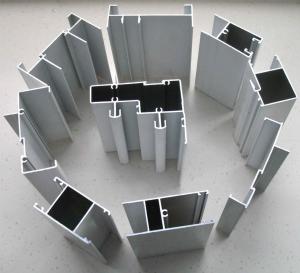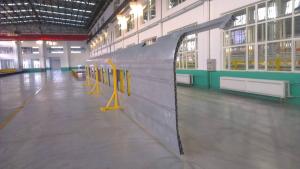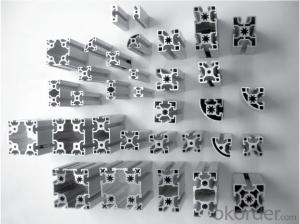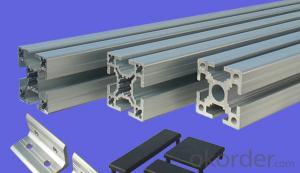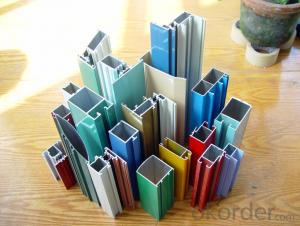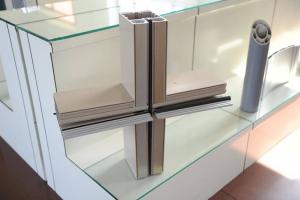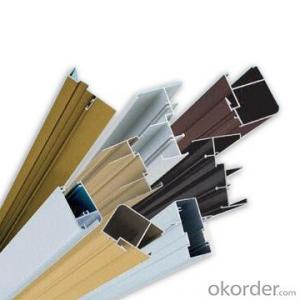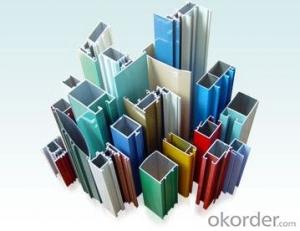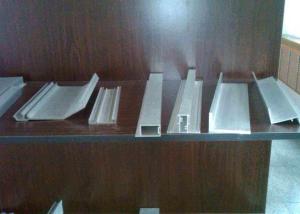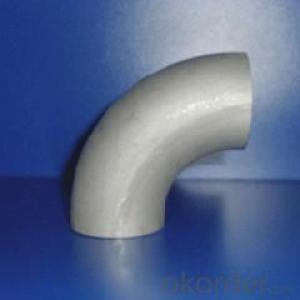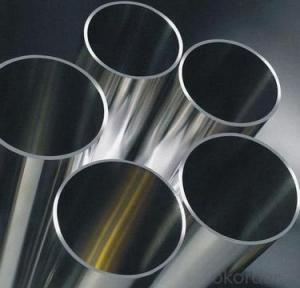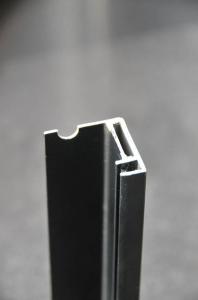Aluminum Anodized Window Profiles
- Loading Port:
- China Main Port
- Payment Terms:
- TT OR LC
- Min Order Qty:
- -
- Supply Capability:
- -
OKorder Service Pledge
OKorder Financial Service
You Might Also Like
ALUMINUM ANODIZED PROFILE
Industrial aluminium profile
1)Material : 6063 6061 6060 and different aluminium alloy
2)Status:T4 T5 T6 or other special status
3)Surface treatment: mill finish, anodized sliver ,anodized bronze, anodized champagne, anodized black pearl, various power coating color, electrostatic sliver, electrostatic champagne, electrostatic golden, electrostatic titanium , machine polish sliver, machine polish bronze, wooden grain color, and Fluorocarbon spraying.
4)Annual capacity : 120000TON
5)Quality : China Nation Standard GB/T 5237 2008 (advanced class)
6)Use: can be widely using aluminium window, door, curtain wall, hand railing , normal aluminium profile, decorative and industrial aluminium profile
7)Advantage: Famous Brand reasonable&market price, soonest delivery and good after sale- service
8)Type of package:protection foam+heat contracted plastic film. / wooden packing / Metal pallet or depand on clientspecial requirement.
9)Payment term:T/T:30% of total value as deposite should paid by T/T within 3 days when confirmation ,and the remaining sum should be paid by T/T before delivery.L/C: 100% at sight
10)Delivery Day: 15-30days
11)Honor : CHINA FAMOUS TRADEMARK, CHINA TOP BRAND, ISO9001-2000, CHINA SQUARE&ROUND COMMITTEE DNV
- Q: Can aluminum profiles be used in modular wall systems?
- Yes, aluminum profiles can be used in modular wall systems. Aluminum profiles are lightweight, durable, and versatile, making them an ideal choice for constructing modular walls. They can be easily assembled, disassembled, and reconfigured to meet specific design requirements. Additionally, aluminum profiles offer excellent structural integrity and can accommodate various finishes, such as glass panels or cladding, enhancing the aesthetics of the modular wall system.
- Q: What are the recycling capabilities of aluminum profiles?
- Aluminum profiles have excellent recycling capabilities due to the inherent properties of aluminum as a material. Aluminum is highly recyclable, meaning it can be processed and reused repeatedly without losing its quality or properties. The recycling process for aluminum profiles involves melting them down to remove any impurities or coatings, and then shaping them into new profiles or other aluminum products. One of the key advantages of recycling aluminum profiles is the significant energy savings it offers compared to producing new aluminum. Recycling aluminum requires only around 5% of the energy needed to extract and refine primary aluminum from bauxite ore. This energy efficiency not only reduces the environmental impact but also contributes to cost savings in the production process. Additionally, recycling aluminum profiles helps conserve natural resources as it reduces the need for mining and extraction of bauxite. By reusing existing aluminum, we can preserve valuable resources and minimize the ecological footprint associated with the extraction and transportation of raw materials. Furthermore, aluminum profiles are highly valuable in the recycling industry due to their high scrap value. The scrap aluminum market is well-established, allowing for easy collection and processing of discarded profiles. This incentivizes individuals and businesses to recycle their aluminum waste, as they can potentially earn money from selling it to scrap dealers or recycling centers. Overall, the recycling capabilities of aluminum profiles are impressive, making them a sustainable choice for various industries. By promoting the recycling of aluminum profiles, we can reduce energy consumption, minimize resource depletion, and contribute to a more environmentally friendly and economically viable future.
- Q: Aluminum profile 606360056061, T5 and T6 hardness GB, how much?
- Generally divided into Vivtorinox hardness, Rockwell hardness and Vickers hardness and webster hardness. Our enterprises are generally in accordance with webster hardness test, GB 6063-T5 8HW 6063-T6 11.5HW6005-T5 15HW 6005-T6 15HW6061-T5 15HW 6061-T6 15HWIf you need other hardness units, you can refer to the conversion
- Q: Can aluminum profiles be custom-designed?
- Yes, aluminum profiles can be custom-designed to meet specific requirements and specifications. The flexibility and versatility of aluminum as a material allow for various shapes, sizes, and finishes, making it suitable for customization in various industries such as construction, automotive, and manufacturing. Custom-designed aluminum profiles can be tailored to specific applications, ensuring optimal functionality and aesthetics.
- Q: Aluminum profile spraying process
- Pretreatment -- drying, removing moisture -- spraying -- Inspection -- baking -- Inspection -- finished.1, construction requirements, general powder spraying construction requirements:(1) in order to give full play to and extend the service life of the coating, the surface of the coating is strictly treated by surface pretreatment first(2) when spraying, the coating must be completely ground to increase the spraying efficiency of the powder coating(3) to be coated with larger surface defects, it should be coated with conductive putty to ensure the smooth and smooth coating(4) after the spraying, the objects and articles should be heated, cured and solidified. The technical indexes of the powder products should be adopted, but the curing temperature and time should be guaranteed so as to avoid the quality failures caused by solidification(5) check immediately after spraying, if found defects should be timely treatment, if after curing defects are found, the only local small range without affecting, the coated surface decoration, can use the same color powder and acetone diluted to repair, if the scope is large and affects the surface quality, use sandpaper after again. Or use the paint remover to remove the coating, re Suo powder.(6) the recovered powder must be screened and removed, and then mixed with the new powder at a certain proportion(7) the powder supply barrel, the powder spraying room and the recycling system should avoid contamination by other colors. Therefore, each color change must be cleaned
- Q: Are aluminum profiles capable of being tailored to fit unique design specifications?
- <p>Yes, aluminum profiles can be customized to meet specific design requirements. This customization includes altering dimensions, surface treatments, and shapes to fit the needs of various applications. Manufacturers can cut, bend, and machine aluminum profiles to precise specifications, allowing for a high degree of flexibility in design and functionality. Customization is often possible through processes like extrusion, which allows for the creation of complex profiles that can be tailored to exacting standards.</p>
- Q: What are the advantages of using aluminum profiles in transportation vehicles?
- There are several advantages of using aluminum profiles in transportation vehicles. Firstly, aluminum is a lightweight material, which helps to reduce the overall weight of the vehicle. This, in turn, improves fuel efficiency and reduces emissions. Additionally, aluminum profiles offer excellent strength-to-weight ratio, providing structural integrity and safety to the vehicle. Aluminum is also corrosion-resistant, ensuring durability and longevity of the vehicle. Moreover, aluminum profiles can be easily fabricated, allowing for flexible and efficient manufacturing processes. Overall, the use of aluminum profiles in transportation vehicles brings benefits such as improved fuel efficiency, enhanced safety, and increased durability.
- Q: Are aluminum profiles suitable for use as exterior walls in residential buildings?
- <p>Yes, aluminum profiles can be used for exterior walls in residential buildings. They offer several advantages such as durability, low maintenance, and resistance to corrosion. Aluminum profiles are lightweight, which makes them easier to install compared to heavier materials. They also have good thermal conductivity, which can be managed with proper insulation to maintain energy efficiency. Additionally, aluminum can be powder-coated in various colors, offering design flexibility. However, it's important to ensure that the aluminum profiles meet building codes and standards for structural integrity and weather resistance.</p>
- Q: Explain the various uses of aluminum profiles in architectural design.
- <p>Aluminum profiles have a wide range of applications in architectural design due to their strength, durability, and versatility. They are commonly used for curtain walls, which provide a sleek and modern appearance while offering thermal insulation. Aluminum profiles are also used in window and door frames for their lightweight and strong properties, enhancing security and energy efficiency. They are integral in the construction of sun shading systems and louvers, which help control light and heat in buildings. Additionally, aluminum profiles are used in structural components like beams and columns, as well as in decorative elements such as facades and balustrades, offering both functional and aesthetic benefits.</p>
- Q: How do you prevent galling or seizing with aluminum profiles?
- To prevent galling or seizing with aluminum profiles, there are a few measures you can take: 1. Lubrication: Apply a suitable lubricant to the contact surfaces of the aluminum profiles. This reduces friction and heat generation, which helps prevent galling or seizing. Choose a lubricant specifically designed for aluminum to avoid any adverse reactions. 2. Surface treatment: Implement surface treatments such as anodizing or applying a protective coating to the aluminum profiles. These treatments create a barrier between the profiles, reducing direct metal-to-metal contact and minimizing the chances of galling or seizing. 3. Proper design and materials: Ensure the design of the profiles and their mating components allows for sufficient clearance and proper fit. Avoid tight tolerances that can lead to excessive contact pressure, increasing the likelihood of galling. Additionally, select materials with compatible hardness and avoid using dissimilar metals that can lead to galvanic corrosion. 4. Cleanliness: Keep the aluminum profiles and their mating surfaces clean and free from dirt, debris, or contaminants. Any foreign particles can increase friction and contribute to galling or seizing. 5. Regular maintenance: Implement a preventive maintenance program that includes periodic inspection, cleaning, and lubrication of the aluminum profiles. This helps identify any issues early on and ensures continued smooth operation. By following these preventive measures, you can minimize the risk of galling or seizing in aluminum profiles, ensuring their longevity and optimal performance.
Send your message to us
Aluminum Anodized Window Profiles
- Loading Port:
- China Main Port
- Payment Terms:
- TT OR LC
- Min Order Qty:
- -
- Supply Capability:
- -
OKorder Service Pledge
OKorder Financial Service
Similar products
Hot products
Hot Searches
Related keywords






